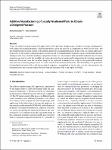Search
Author
- Defanti, Silvio (1)
- Galati, Manuela (1)
- Galiullin, T. (1)
- Pillai, R. (1)
- next >
Subject
- Designed Fracture (1)
- EDX/WDX (1)
Date issued
- 2023 (2)
Has File(s)
- true (2)
Search Results
Today, the additive manufacturing (AM) approach has led to profound changes in part and process design, enabling previously impossible material properties. With the freedom to create the material as components are built layer by layer, AM has permitted precise spatial control of the material properties in manufactured parts. In this work, an original approach is proposed to locally control component and process design and create intentionally weakened regions with designed fracture, which paves the way to tuneable mechanical properties. Tensile tests of specimens with embedded weakened area of various geometries are used to verify the feasibility of a-priori-designed fracture modes and to characterise the variation in material behaviour. The results show that an ad hoc design of the... |
High-temperature oxidation behavior of conventionally cast and additively manufactured (AM) Co-base alloy MAR-M-509 was compared in the present study. The specimens were exposed in air at 1000 °C and characterized by means of scanning electron microscopy equipped with energy/wavelength dispersive x-ray spectroscopy (EDX/WDX) and electron backscatter diffraction as well as transmission electron microscopy. Substantial differences in the oxidation processes of two alloy versions were observed. Faster oxidation of the cast alloy was mainly induced by (1) oxidation of coarse primary carbides, (2) internal oxidation and nitridation processes and (3) incorporation of other alloy constituents (e.g., Co, Ni, W) into the Cr-oxide scale. AM specimens, in contrast, formed a more homogeneous, t... |


